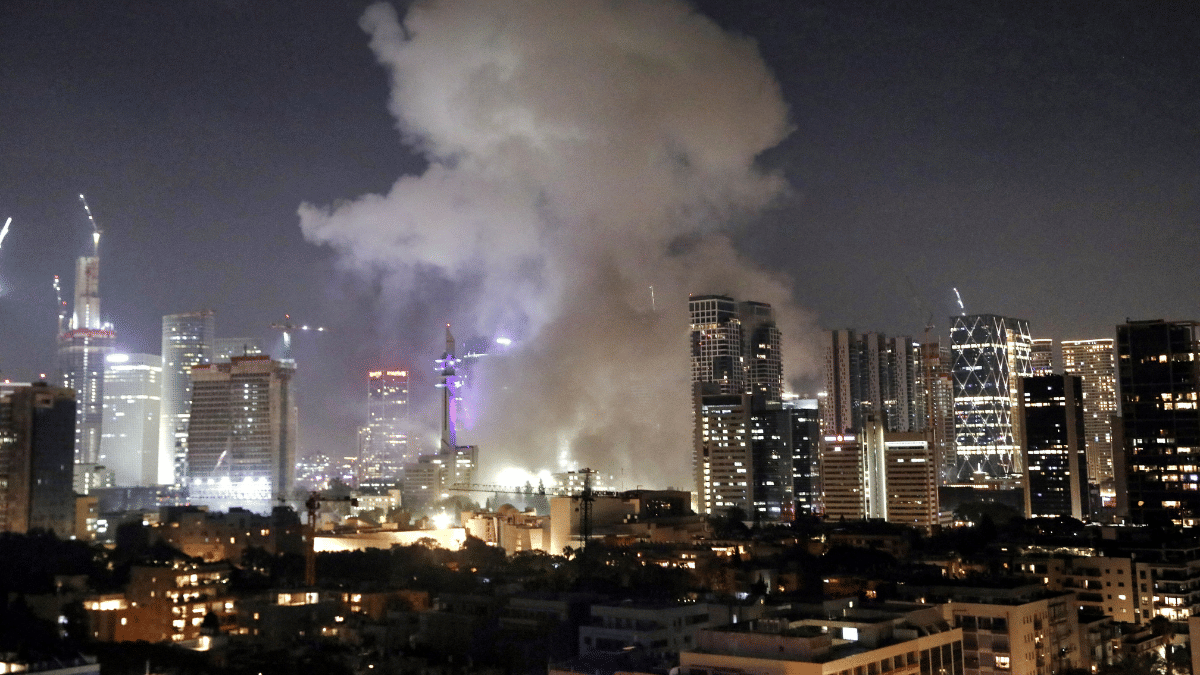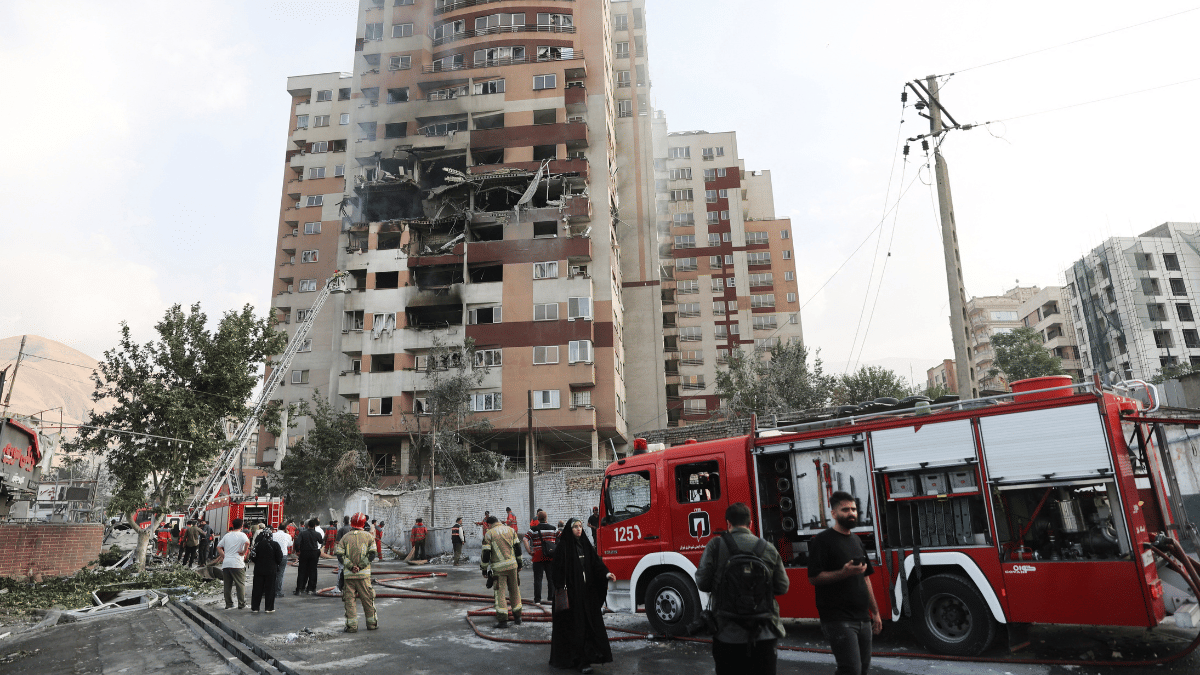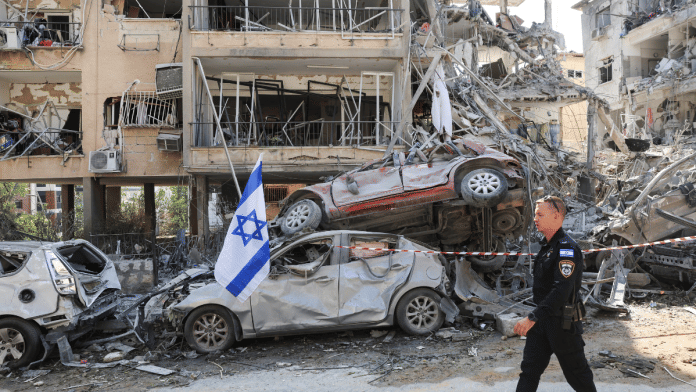New Delhi: Iran’s modern history has been shaped by a series of conflicts that has defined its political identity. From the 1979 Iran hostage crisis—a diplomatic standoff with the US—to its ongoing confrontation with Israel after Tel Aviv’s military ‘preemptive’ strikes on key nuclear sites and the killing of senior Iranian military officials, Iran has seen recurring tensions.
A day before the strikes Friday, the International Atomic Energy Agency (IAEA) board, for the first time in 20 years, passed a resolution calling out Iran for breach in its non-proliferation duties, after Iran failed to provide credible explanations for the presence of uranium particles of anthropogenic origin at three nuclear sites.
Israel attacked Iran Saturday with a stated objective to contain Tehran’s accelerated nuclear advancements amid stalled talks between Washington and Tehran to strike a nuclear deal.
Iran has hit back fiercely. Both sides have suffered casualties in the latest round of conflict.
Iran’s enmity with Israel and the US has only deepened over time, witnessing multiple direct and proxy wars, covert operations, and missile strikes.
It all started with a hostage crisis 46 years ago.
The Iranian hostage crisis 1979
On 4 November 1979, Iranian students seized the U.S. embassy and detained more than 52 Americans, ranging from the chargé d’affaires to the junior most members of the staff after a successful Islamic revolution led by Ayatollah Ruhollah Khomeini to overthrow the pro-American Shah of Iran, Shah Mohammad Reza Pahlavi.
The crisis precipitated after Washington allowed the ousted Shah of Iran to travel to the US for medical treatment.
After six months of diplomatic standoff, the US launched a military operation in Tehran 24 April 1980, to rescue the hostages. The operation ended with eight U.S. service personnel dead without rescuing any hostage.
The Americans remained hostage for 444 days until a deal was brokered by Algerian intermediaries 20 January 1981 to secure the release of all 52. The US had to free almost $8 billion of Iranian assets frozen in US banks.
After the crisis, Iran largely remained isolated in the international community. Then followed the protracted Iran-Iraq war, which lasted eight years.
Also Read: Israel-Iran conflict: India distances itself from SCO statement critical of Tel Aviv
Iran-Iraq war
On 22 September 1980, Iraq launched a full-scale invasion of neighbouring Iran. It took nearly eight years to achieve a ceasefire. Half a million soldiers and civilians died during the conflict which ended in a stalemate.
The invasion happened after Saddam Hussein became the president of Iraq in July 1979. Saddam feared an expansion of Iran’s revolution to Shi’ite-dominated Iraq and sought to overturn border agreements of 1975—that resolved their longstanding border disputes, particularly concerning the Shatt al-Arab waterway—to re-assert control over both sides of Shatt al-Arab, Iraq’s only access point to the Persian Gulf.

Initially, Iraq captured the oil producing city of Khorramshahr and used chemical weapons against Kurds. But in 1981, Iran launched a counter-offensive. By early 1982, Iran virtually gained all lost territory. In July 1982, it invaded Iraq, unsuccessfully though.
In July 1988, after many failed offensives and counter-offensives, both countries agreed to a UN-brokered ceasefire under security council resolution 598. The war officially ended 20 August 1988.
Iran’s only allies during the conflict were Syria and Libya.
Tanker War: land to sea
What began as conflict on land, soon ratcheted up and played out in the seas too. It was called the “Tanker War”, where both sides attacked each other’s merchant ships and oil tankers in the Persian Gulf and the Strait of Hormuz. Apart from their own ships, neutral ships were also targeted, leading to an internationalisation of the conflict.
Atlas I, a Turkish oil tanker, was the first to be hit by Iraq. Greek tanker Scapmount also became a casualty of an Iraqi attack. The attacks led to an increased naval presence of the US and other western powers in the Gulf.
Israel’s invasion of Lebanon & role of Hezbollah & Iran
Hezbollah, a militant-group-turned political party, first emerged during Lebanon’s civil war (1975-1990). Its aim was to resist the Israeli invasion of southern Lebanon in 1982 to stem the Palestine Liberation Organisation’s attack on Israel.
Hezbollah has close ties with Iran and is a key component of Iran-led Axis of Resistance, a loose military network of militant groups and State-controlled forces in the middle east, supported by Iran and its Islamic Revolutionary Guard Corps.
The Axis comprises Hezbollah in Lebanon; Palestinian armed group Hamas; and Palestinian Islamic Jihad (PIJ) in the Gaza strip and the west bank; and the Houthis in Yemen. It has proxy relationships with a wide range of groups in Iraq, Syria, Lebanon, and Bahrain.
By June 1982, both Syria and Israel were fighting in Lebanon. Iran aided militias fighting Israel and at one point, Hezbollah surpassed the Lebanese army as the country’s predominant armed force. They are also called Junior partners to Iran’s Quds forces.
Israel signed an agreement with Lebanon terminating the state of war between the neighbours. A multinational peacekeeping force, composed of troops from the US, France and Italy arrived in Lebanon in August 1982 as part of the ceasefire agreement signed by Israel and the PLO. Islamic Revolutionary Guard Corps (IRGC) personnel were also deployed in the Bekka valley of Lebanon as part of a multinational force.
But, on 23 October 1983, a dump truck with estimated 12000 pounds of explosives crashed through the gates of US marine barracks of peacekeeping force and killed 241 marines. A second suicide bomber drove into barracks of French paratroopers and 58 soldiers were killed.
The responsibility was claimed by Hezbollah. Peacekeeping forces were withdrawn from Lebanon.
On 3 March 2008, however, Iraq Shia-dominated Iraq welcomed then Iranian President Mahmoud Ahmadinejad to Baghdad.
Also Read: Israel crushed Ayatollah’s regime, but stopping Iran’s nuke programme will need total overthrow
Terror attacks on Israeli Embassy in Argentina
On 17 March 1992, the Israeli embassy in Buenos Aires, Argentina, was attacked by terrorists, resulting in 29 deaths. Among the dead were Israelis and Argentinians, mostly children. The attack was attributed to Islamic Jihad—an affiliate of Hezbollah.
Another attack happened 18 July 1994, targeting a Jewish community in Argentina and killing 85 people. The investigation revealed ties between various actors in the middle east, particularly in Iran and Syria.
On 25 June 25 1996, a tanker carrying 25000 pounds of explosives ripped the US Air Force military housing complex Khobar Towers in Dhahran, Saudi Arabia, resulting in the death of 19 US Airmen and wounding nearly 500 others.
The attack was so powerful that it dismantled an eight-story building, leaving a crater of 50 feet wide and 16 feet deep. This was the deadliest attack against US forces since the 1983 bombing of marine barracks in Beirut that left 241 dead.
The attackers were identified as members of Pro-Iran Islamic militant group Saudi Hezbollah.
On 12 July 2006, a war erupted between Israel and Hezbollah after Hezbollah fighters killed eight Israeli soldiers and kidnapped a pair of others. The 34-day war ended on 14 August.
Yemen civil war
The Yemen civil war started after the Arab Spring of 2011, an uprising that forced the authoritarian Ali Abdullah Saleh to hand over power to his deputy Abdrabbuh Mansour Hadi. He could not manage the resistance from Saleh loyalists.
In 2014, Houthi Shia militants benefited from his weakness and seized control of Sadda province and capital Sanna.

The conflict escalated when in 2015 as Saudi Arabia and eight other Sunni countries backed by US-led forces declared to restore the Hadi government, launching operation Decisive Storm to prevent Iran’s control over the Bab El-Mandeb Strait, which connects the Red Sea to the Gulf of Aden and by extension the Indian Ocean.
They struck Houthis, intending to drive them out. Saudi Arabia accused Iran of backing the Houthis with weapons and logistical support, but Iran denied the charge.
Iranian missiles strike on US bases in Iraq
US troops left Iraq 18 December 2011. Since 2011, Iran continues to have significant influence in Iraq by supporting Shia militias, via economic, cultural, and religious links. These militias are now parts of PMF (Popular Mobilisation Forces). Iran uses Iraqi militias in proxy-conflicts including against US forces.
On 8 January 2020, Iran attacked two US bases in Iraq by launching 12 ballistic missiles with an aim to force all US forces out of the region. It followed the assassination of top Iranian military commander Qassem Soleimani in a missile strike outside the Baghdad international airport on the orders of President Trump five days ago.
Also Read: Attacking Iran’s nuclear programme won’t bolster Israel’s national security
Iran’s Taliban problem
The Taliban’s return to power in Afghanistan in August 2021 has remained a cause of concern for Iran. There have been border skirmishes and a contest over water resource sharing. The key issue has remained ideological one, the Taliban as purist followers of Islam’s dominant Sunni faith, Iran, a Shi’ite state.
Iran’s foreign ministry issues a statement every year on 8 August as a “reminder of very bitter memory” of an attack on its consulate in northern Afghanistan’s Mazar-e-Sharif city on that day in 1998—that killed eight diplomats and a journalist of I.R.N.A—and seeking clarification from Taliban authorities.
On 8 August 1998, Taliban militia forces captured the city of Mazar-e-Sharif in northwest Afghanistan. Within the first few hours of capture, Taliban troops killed scores of civilians in indiscriminate attacks. Iran’s consulate was also a casualty of the Taliban’s ‘killing spree’.
Hamas attack on Israel
On 7 October, 2023, Hamas attacked Israel, killing about 1,200 people and taking more than 250 hostages under the leadership of Ismail Haniyeh. It triggered a massive Israeli military offensive in Gaza killing and displacing thousands of Palestinians along with top Hamas leadership. Ismail was assassinated while visiting Tehran, Iran in July 2024.
Iran president congratulated Hamas for attacking Israel.
The WSJ reported the Hamas attack on Israel was green lit by Iran. Iran’s modus operandi in the middle east has largely remained a proxy war, backing militias with financial aids, training and arms support.
The last direct confrontation with Israel
On 13 April 2024, Iran attacked Israel with around 170 drones, over 30 cruise missiles and more than 120 ballistic missiles to avenge Tel Aviv’s attack on Iranian embassy in Damascus 13 days ago.
Iran had long avoided a direct conflict since 1988 except for its responses in 2020 and 2024 against both Israel and the US.
Through various covert programmes like Operation Olympic Games—a cybeattack by introducing malware in Iran’s nuclear centrifuges to disrupt its cycles—the US and Israel have tried to sabotage Iran’s nuclear progression time and again.
Israel, claiming existential threat by Iran’s advancement of weapon grade nuclear abilities, chose to strike first Friday as final measure with the stated aim of taking out Tehran’s nuclear capabilities.
(Edited by Ajeet Tiwari)
Also Read: New round of Iran nuclear negotiations begins. Time to talk about Israel’s atomic bombs too







What confrontation?
History stands testimony to the fact that each and every time Israel has singlehandedly whooped the ass of the Arab nations. If not restrained by the USA, Israel could easily possess and rule over the entire Arabian peninsula.